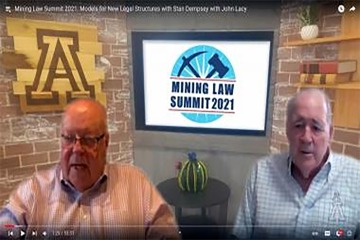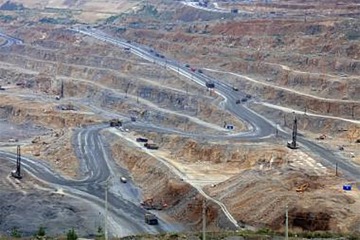Summit explores best models for complex mining law issues

As permits for mining operations become more complex and expensive to obtain, U.S. companies ought to look at new legal structures that provide better assurances that the economics are worth moving forward.
In particular, the Town and Country Planning Act in Great Britain can serve as a model for U.S. government entities, private citizens and organizations, and companies, said renowned mining industry professional Stan Dempsey during an hour-long discussion at the University of Arizona’s November 2021 Mining Law Summit.
“Models for New Legal Structures” looked at how to balance varied interests when a mining operation is proposed while still giving the developer a stable financial and regulatory environment in which to operate the mine. Dempsey, a National Mining Hall of Fame inductee who is former board chairman of Royal Gold Inc., and John Lacy, director of the UArizona Global Mining Law Center, touted the Great Britain example as a way to address the needs of all sides of mining development. Those planning laws require that all interested parties participate early in the permitting process to voice and hash out concerns, compromises and solutions. These include issues of environmental and social impacts and governance of mitigating activities. “Everything is pulled together in an overall evaluation,” Lacy explained. A single permit is eventually issued at the national level and only one appeal can challenge the process.
Mine developers in the United States currently pursue permits from several government agencies. Each agency holds separate public hearings after plans and environmental assessments are submitted. Challenges, sometimes in court, can happen at each permitting stage. This protracted process takes an average of four years in the United States, compared to two years using the model in Great Britain and some other countries. “Each of the stakeholders have legitimate interests that they’re advancing and want to preserve,” Dempsey said. “It’s time to really listen to other people.” United States agencies and companies need to refashion the permitting process. “We need a completely new environmental impact assessment,” he said, that upfront addresses political, social and economic effects.
Governments need to play bigger roles

A more nationalistic approach to getting mining operations funded and approved—pressing needs as demand grows for rare earth minerals that drive green activities against climate change—might have governments partner with companies. Dempsey called this the 50/50 partnership. In exchange for addressing and paying for environmental and social impacts, a company should get assurances of stability regarding royalties, taxes, export rules, infrastructure development and other business considerations. “It’s really a question of how much will the host country get out of this operation and how much for the company,” he said.
Lacy cautioned that there are dangers in such partnerships. Developing countries may put undue burdens on mining developers to provide treasure to governments without earning fair profit. Missteps in dealing with political unrest could end in abandoning assets. New mining technology might prod a government to change its conditions for operating a mine that could become financially prohibitive for the company. Countries like China and Sri Lanka are willing to invest what it takes to develop mines. They are looking at the long game, said Dempsey, balancing the desires of local special interests with the eventual financial rewards of mining for both the public and private stakeholders.
National oversight may not be enough
Dempsey and Lacy spent some time musing over the possibility that the complexities of launching and maintaining mines are simply too big for one country to control. Here’s when micro- and macro-permitting might save the day. Dempsey noted that indigenous people, in Canada and elsewhere, currently provide services on their lands in agreements to share in the profits.
Robust industry standards that deal with environmental assessments could smooth out the process all over the world. Maybe an organization like the United Nations could referee disputes over permits that involve governments, companies and special interest groups. Individual mining companies face huge investment risks when trying to balance profit with stewardship. These risks could change the fundamental way mines are developed. Said Dempsey: “I have a fear that private industry may not have a place in major mining in the future.”
The annual Mining Law Summit is sponsored by the Global Mining Law Center, part of the UArizona James. E. Rogers College of Law, and the Lowell Institute for Mineral Resources.

